Earth has experienced five events when at least 75% of all species died out over a short amount of geological time. The most recent of those 'Big Five' mass extinctions occurred 66 million years ago (MYA). While famous for killing the dinosaurs, the fifth mass extinction also shaped the wildlife we see today.
While there are several controversial explanations, the leading theory for the actual 'kill mechanism' is that a 10km-wide asteroid smashed into Earth, leaving a crater 180km across at Chicxulub in Mexico. A thermal pulse from heated debris spread across the globe, while the force of collision – equivalent to millions of atomic bombs – created shockwaves that triggered earthquakes, then tsunamis and wildfires.
The impact launched a vast dust cloud into the atmosphere, which coincided with gas released from volcanic activity and blocked-out the sun for years. That led to a nuclear winter and limited photosynthesis, which ultimately powers most life, and that in turn caused a collapse of our planet's ecosystems.

Did all dinosaurs go extinct?
Not quite – because birds are living dinosaurs! To distinguish birds – the class Aves – from prehistoric reptiles, extinct groups are known as 'non-avian dinosaurs'. They were the dominant terrestrial vertebrates of the Mesozoic era (252-66 MYA) throughout the Triassic, Jurassic and Cretaceous periods.
Because the fifth extinction occurred at the boundary between the Cretaceous (K) and subsequent Palaeogene (Pg) period, it's also called the end-Cretaceous or K-Pg event. Other reptiles commonly mistaken for dinosaurs went extinct during the event, including the winged pterosaurs and aquatic plesiosaurs and mosasaurs.
What is a dinosaur?
The word 'dinosaur' stems from the Greek for 'terrible lizard', but dinosaurs aren't actually lizards. That distinction is based on anatomical features. Most notably, a lizard's legs stick-out at right angles from its body, producing a sprawling stance, but a dinosaur's legs are tucked underneath. Keeping a reptile upright requires strong joints between hips and backbone, which ancestors of dinosaurs made after fusing together vertebrae to form a modified structure, the sacrum.
What was the first dinosaur?
The origin of dinosaurs dates back to around 230 MYA. Dinosaurs emerged from a group of reptiles called archosaurs, which has a 'crocodile line' (Crurotarsi) and 'bird line' (Avemetatarsalia), defined by bones near the ankle. There are a few candidates for oldest species – including small carnivores like Eoraptor, larger Herrerasaurus, and omnivores such as Panphagia – but no frontrunner for the first dinosaur, which evolved from the 'bird line' of archosaurs. Early dinosaurs walked on their hind legs, but not all their descendants were bipedal, which suggests that walking on four legs evolved several times independently.
Where did dinosaurs live?
Dinosaurs appeared during the late Triassic, a period when present-day land masses existed as a single supercontinent, Pangaea. After Pangaea started to break apart around 200 MYA, dinosaurs were distributed across the globe. They occupied a range of terrestrial habitats, from arid deserts to floodplains.

Which dinosaurs appeared in Jurassic Park?
The dinosaur family tree is split into two branches based on hip-bone anatomy: 'bird-hipped' ornithischians and 'reptile-hipped' saurischians.
Ornithischian species feature the armoured Stegosaurus and Ankylosaurus, the duck-billed Parasaurolophus and horn-faced Triceratops. Saurischians include two major dinosaur groups: sauropods and theropods. Sauropods were long-necked herbivores like Brachiosaurus.
Theropods are the most diverse group and contained well-known meat-eaters like Tyrannosaurus rex, which was as big as a double-decker bus, and turkey-sized Velociraptor.
All of the above dinosaurs starred in the Jurassic Park movie franchise (although some characteristics were fictional), along with the flying pterosaur Pteranodon and marine monster Mosasaurus.

How many dinosaur species are there?
About a thousand non-avian dinosaurs have been identified in the fossil record, but a mathematical model estimates that around 2,000 species of dinosaur existed during the Mesozoic era – around 500 ornithischians, 500 sauropods and 1,000 of the more diverse theropods.
Confusingly, birds aren't descended from the 'bird-hipped' ornithischian group, but 'reptile-hipped' theropods. Add 10,000 species of living birds to the total and you get an even larger number of dinosaurs.
How did dinosaurs get so big?
Some dinosaurs were the heaviest animals to ever walk the Earth, reaching sizes far bigger than the largest land mammals. Giant sauropods known as 'titanosaurs' weighed around 50,000kg, for example, the same mass as 10 elephants. Observing cross-sections of fossilised bone under a microscope has provided some insights into how physiology and biomechanics allowed dinosaurs to get big: like those of mammals, dinosaur bones were packed with blood vessels, which may have helped provide the nutrients needed for speedy growth. Juvenile sauropods grew at a rapid rate and their bones became compact in the outer layers: after hatching from an egg, a young 10kg sauropod could become a 10-tonne adult after only a decade or so, a feat that would take crocodiles around a century to complete.
Were dinosaurs warm-blooded?
Possibly, but it's hard to prove. Warm-blooded vertebrates (endotherms) need to eat massive amounts of food to generate enough energy to heat their bodies. One calculation suggests a 40-tonne sauropod would have had to consume over a tonne of plant matter each day, three times that of cold-blooded animals (ectotherms) of equivalent size. Instead, large dinosaurs could have been 'gigantotherms' that conserved heat through sheer body mass to maintain a stable core temperature.
Did dinosaurs have feathers?
Not all, only some. Therapod dinosaurs had feathers, which probably evolved for insulation, serving the same function as feathers on living birds like penguins. Bird feathers were later repurposed for gliding, then powered flight. The other groups of dinosaur, ornithischians and sauropods, didn't usually have feathers.
How were other animals affected?
Although dinosaurs get almost all the attention, the fifth mass extinction had effects across the tree of life – not just on land, but in water too. In fact, the Big Five events were originally defined not by mere species, but by dramatic drops in diversity for entire families of organisms, as measured from fossilised marine creatures. For example, all ammonites – cephalopods with spiral shells closely related to octopus and squid – disappeared following the fifth event.
The thylacine became extinct in the 1960s… or did it?
Tantalising sightings of this enigmatic Australian marsupial continue to inspire the belief that it could still be out there.
© Michelle Thompson @ handsome frank
Why did certain species survive the fifth mass extinction?
That's the big mystery! Mass extinctions aren't random, they're selective, and there are clues that help explain why some species were survivors while others were victims. One contributing factor is characteristics associated with feeding and diet. For example, after the fifth extinction, natural selection was biased against large bony fishes with fast-closing jaws.
An ability to use available food sources could also be the reason why some birds survived when all other dinosaurs died out: the ancestors of modern birds ('neornithines') had solid beaks instead of tiny teeth, which probably enabled them to break-open seeds.
Why did mammals become so successful after the fifth mass extinction?
Life has always bounced back from mass extinctions eventually, as the surviving groups colonise the ecological niches left vacant by their extinct competitors or predators. Although all classes of vertebrates recovered in the aftermath of the fifth extinction, mammals achieved the greatest success at taking advantage of the dinosaurs' demise by evolutionary radiation – a rapid rise in diversity that gave the ongoing Cenozoic era its nickname, the Age of Mammals.
Scientists believe mammals became successful because they're generally smarter than other animals but, for 10 million years following the fifth event, body size ballooned from small shrew-like forms. So at least at first, it was brawn before brains.
Was the fifth mass extinction special?
Maybe. Unlike the other Big Five events, which unfolded over thousands of years, the fifth mass extinction began with a bang – the 'final day' of the dinosaurs – so the timing of the asteroid strike may have been significant.
Based on fish which supposedly died the same day, from the Tanis fossil site in North Dakota, some scientists say the impact only killed certain species because the asteroid hit the Northern hemisphere in spring – a time when animals are hibernating or reproducing. How that had knock-on effects across the globe is another mystery.
Main image: Illustration of the K/T Event at the end of the Cretaceous Period. A ten-kilometre-wide asteroid or comet is entering the Earth's atmosphere as dinosaurs, including T. rex, look on. © Roger Harris/Science Photo Library/Getty
